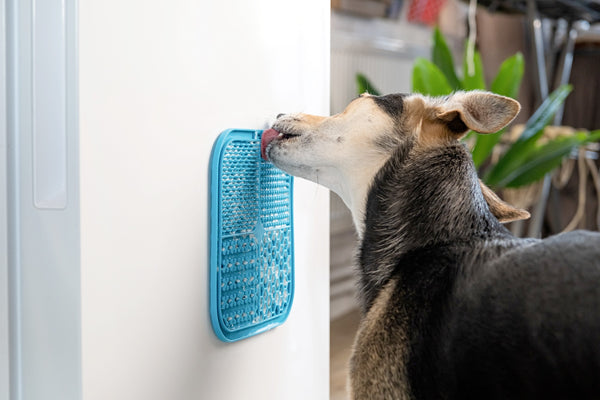Watching our dogs race around a park, tongues out and tails wagging is a source of immense joy. Dogs are playful, inquisitive creatures that thrive on interaction and challenge. However, just like humans, dogs can get bored.
When they do, a dog's boredom can resort to behaviors that may not mesh well with our domestic lives—like barking non-stop, chewing on furniture, or digging up the garden. In the world of dog psychology, a bored dog is a precursor to a host of troublesome behaviors. So, how can you keep a dog's brain as active as its body? Let's find out.
The Importance of Mental Stimulation for Dogs
Mental stimulation is crucial for our furry friends and is as important for them as physical exercise. Dogs are intelligent animals that need to be intellectually engaged to prevent boredom. It's not just about tunnel vision; a bored dog can be a destructive force, but a stimulated dog is a balanced and happy companion.
Understanding Boredom in Dogs
When a dog isn't mentally stimulated, they can become visibly restless or disinterested. Many dogs, especially those of high-intelligence breeds, require mental activities to prevent the adverse effects of boredom.
Signs of Boredom
- Excessive barking or howling
- Destructive chewing
- Pacing or restlessness
- Sleeping more than usual
- Seeking attention in a more demanding way
Consequences of a Bored Dog
Not only can a bored dog create a mess around your home, but they can also become depressed or anxious. Some may exhibit obsessive or compulsive behaviors that further stress them out and their owners.

Ideas for Mental Stimulation
There are numerous ways to keep your dog's mind occupied, and the best approach often involves a mix of activities that engage their senses and encourage them to think. Here are several strategies you can employ to keep your canine companion mentally stimulated.
Interactive Toys and Puzzles
Just like humans, dogs can enjoy solving puzzles. Investing in a few good-quality toys and puzzles can provide hours of fun. Look for toys that require active participation or ones that dispense food with some effort on your dog’s part.
Training and Obedience Exercises
Regular training sessions can double as mental workouts. They provide structure and serve as bonding activities that satisfy your dog's need for stewardship and guidance.
Enrichment Activities
Simple and free activities like hiding treats around the house for your dog to find can be a great mental workout. It taps into their natural scavenger instincts and keeps them on their toes.
Food-dispensing Toys
Food-dispensing toys are great for a dog's mental health. They provide a challenge and a reward, which are two things dogs adore. It also slows down their eating, which is a health bonus (especially when a food dispensing toy for daily supplements!).
Social Interactions
Dogs are social animals, and they enjoy interacting with their human family members or other dogs. Whether it's a game of fetch or tug-of-war, playtime is an excellent way to keep your dog engaged mentally and physically.
Creating a Daily Routine
Consistency is key when it comes to providing mental stimulation for bored dogs. Create a routine that you and your dog can stick to. Providing a structured day ensures that they'll know what to expect and when to expect it, reducing uncertainty and potential anxiety.
Structured Playtime
Whether it's a game of fetch, tug-of-war, or hide-and-seek, structured playtime is about quality over quantity. Short, intense bursts of play can be just as beneficial as long, drawn-out play sessions.

Regular Exercise
Physical activity is closely tied to mental stimulation in dogs. A good walk, jog, or other dog sports should be part of any mental health enrichment program you have for your pup. A tired dog after some mental and physical stimulation is a well-behaved dog.
Mental Challenges Throughout the Day
Incorporate mental challenges like a quick training session or a food puzzle into your dog's daily routine. It breaks up the day and gives them something to look forward to.
Additional Tips for Mental Stimulation
There are even more ways to keep your dog's brain ticking. Here are some creative ideas that you might not have considered.
New Experiences
Meeting new dogs, people, and environments broadens your dog's horizons. It provides new sights, smells, and experiences, all of which are mentally enriching.
Rotating Toys and Activities
Dogs can get bored of the same old chew toys and activities, so keeping things fresh is important. Introduce new puzzles to their toy box or switch up the way you use existing toys to keep things interesting.
Engaging With Nature
Going for a hike or exploring a new trail offers a wealth of sensory experiences that can keep your dog enthralled. Nature provides an ever-changing environment that is the antithesis of a dull day.
The Benefits of Keeping a Mentally Stimulated Dog
The effort put into keeping your dog mentally stimulated doesn't go unnoticed. A stimulated dog is not just well-behaved; they are often more confident and can learn new things faster. It also strengthens the bond between you and your pet as you navigate and explore the world together.
Boredom is no joke, especially not in our four-legged friends. By investing time and resources into keeping your dog mentally stimulated, you're ensuring their good health and happiness—and that's a win for both of you!
FAQs
Q: My dog has separation anxiety and gets destructive when left alone; will mental stimulation help?
A: Yes, mental stimulation can be beneficial for dogs with separation anxiety. It can help redirect their energy and alleviate boredom, which are both contributing factors to destructive behaviors. For dogs with separation anxiety, try incorporating some calming supplements specifically designed for dogs.
Q: How do I know if I am providing enough mental stimulation for my dog?
A: If your dog is exhibiting signs of boredom or engaging in destructive behaviors, it's a good indicator that they need more mental stimulation. You can also consult with a veterinarian or dog trainer for personalized advice. Overall, the key is to provide a variety of mentally stimulating activities and observe how your dog responds.

Q: Can too much mental stimulation be harmful to my dog?
A: It's essential to find a balance and not overwhelm your dog with too many activities at once. Pay attention to their body language and behavior, and make adjustments accordingly. If your dog seems exhausted or stressed, it may be time to take a break from mental stimulation.
Q: My dog is older; do they still need mental stimulation?
A: Yes, mental stimulation is beneficial for dogs of all ages. It can be especially helpful for older dogs who may have less physical energy but still need to engage their minds. Keep in mind that the activities and level of intensity may need to be adjusted for senior dogs.
Q: Can mental stimulation benefit dogs with physical limitations?
A: Absolutely. Mental stimulation can be a great way to engage and entertain dogs who may have physical limitations or injuries. It allows them to use their minds and stay active without putting strain on their bodies.
Q: Are there specific breeds that require more mental stimulation than others?
A: Every dog is unique and has different needs, but some breeds are known to have high energy and intelligence levels that require more mental stimulation. For example, working or herding breeds like Border Collies or Australian Shepherds may need more mental challenges to stay engaged.
Q: Can mental stimulation improve my dog's behavior?
A: Yes, providing regular mental stimulation can help redirect unwanted behaviors like excessive barking or destructive chewing. It gives dogs an outlet for their energy and helps prevent boredom, which can contribute to behavioral issues. However, for serious behavioral issues, it's always recommended that pet parents seek help from a certified dog behavior consultant.
Q: What are some simple ways to incorporate mental stimulation into my dog's day?
A: Some easy ways to provide daily mental stimulation include hiding treats around the house, teaching new tricks or commands, playing scent games, or using interactive toys. Even something as simple as a few minutes of focused playtime can make a difference. Overall, the key is to be creative and switch things up to keep your dog engaged and learning.
Q: Can I use mental stimulation as a form of training for my dog?
A: Yes, mental stimulation can be an excellent way to reinforce training and teach new skills. It keeps most dogs mentally engaged and motivated while working on obedience and other behaviors. Just make sure to use positive reinforcement techniques and keep sessions short and frequent for the best results.
Q: Can I combine physical exercise with mental stimulation for my dog?
A: Absolutely! Combining physical activity with mental challenges can provide an even more enriching experience for dogs. For example, you can incorporate obedience training during walks or play games that require both physical and mental skills. It's a great way to keep your dog healthy and sharp.
Conclusion
Mental stimulation is a crucial aspect of caring for your dog's overall well-being. It not only keeps them entertained and happy, but it also helps prevent behavioral issues and strengthens the bond between you and your pet.
With a little effort and creativity, you can provide your dog with a fulfilling and mentally enriching life. So go ahead, try out some new activities, and see the positive impact it has on your furry friend.













